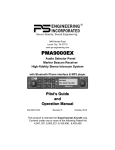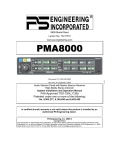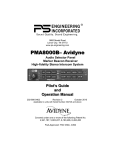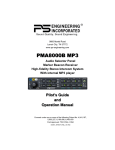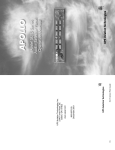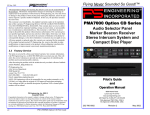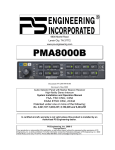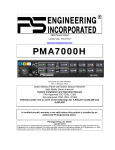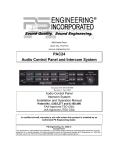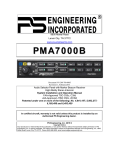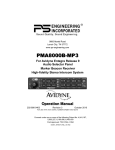Download PS Engineering PMA8000 Operating instructions
Transcript
9800 Martel Road Lenoir City, TN 37772 www.ps-engineering.com PMA8000-Series Audio Selector Panel Marker Beacon Receiver High-fidelity Stereo Intercom System Flying Never Sounded So Good! ™ PS Engineering, Inc. 2004 © Copyright Notice Copyrighted information in this manual is subject to change without notice. PS Engineering reserves the right to improve or change the products or contents of this manual, without notification of any person or agency. The contents of this pilot’s guide may be downloaded, stored and reprinted for personal use provided that this copyright information is included. Commercial use is strictly prohibited. For further information contact the Publications Manager at PS Engineering, Inc., 9800 Martel Road, Lenoir City, TN 37772. Phone (865) 988-9800 12 202-890-0000 PMA8000-Series Pilot Guide 202-890-0000 Pilot’s Guide and Operation Manual April 2004 Patent No. 5,903,277 & 6,160,496 FAA-Approved TSO C50c, C35d PMA8000-Series Pilot Guide 202-890-0000 1 This manual provides detailed operating instructions for the PS Engineering PMA8000, Audio Selector Panel/Intercom Systems. Please read it carefully before using the equipment so that you can take full advantage of its capabilities. This publication is divided into four sections covering the basic operating areas of the PMA8000 systems. They are Communications Transceiver Selection, Audio Selector, Intercom, and Marker Beacon Receiver. PMA8000 controls This will allow the service technician to provide any other suggestions for identifying the problem and recommend possible solutions. After discussing the problem with the technician and you obtain a Return Authorization Number, ship product to: PS Engineering, Inc. Attn: Service Department 9800 Martel Rd Lenoir City, TN 37772 (865) 988-9800 FAX (865) 988-6619 Email: [email protected] Units that arrive without an RMA number, or telephone number for a responsible contact, will be returned un-repaired. PS Engineering is not responsible for items sent via US Mail. Power Switch (1) (EMG-Fail Safe Operation) Unit power is turned on and off by pushing the volume knob. In the OFF or "EMG" position, the pilot headset is connected directly to Com 1. This allows communication capability regardless of unit condition. Any time power is removed or turned OFF, the audio selector will revert to fail-safe mode. The power switch controls all audio selector panel functions, intercom and marker beacon receiver. Communications Transmit (XMT) Selection (2) There are two pushbuttons associated with the transmitter selection. The two lower buttons (item 2) control which transceiver is selected for transmit. The top row of pushbuttons labeled COM 1 and COM 2 allows selection of the receiver audio. Push the lower button to select the desired COM transmitter. The PMA8000-Series has an automatic selector mode. Audio from the selected transceiver is automatically heard in the headsets and speaker (if selected). You can check this function by switching from COM 1 transmitter to Com 2 transmitter by pressing the COM 2 transmitter selector pushbutton. Note that the associated Com 2 receive pushbutton enunciator light that is 2 202-890-0000 PMA8000-Series Pilot Guide PMA8000-Series Pilot Guide 202-890-0000 11 Warranty & Service In order for the factory warranty to be valid, the installations in a certified aircraft must be accomplished by an FAA-(or other ICAO agency) certified avionics shop and authorized PS Engineering dealer. If the unit is being installed by a non-certified individual in an experimental aircraft, a factory-made intercom harness must be used for the warranty to be valid. PS Engineering, Inc. warrants this product to be free from defect in material and workmanship for a period of three (3) years from the date of installation as recorded in aircraft logbook and/or on FAA Form 337. During the first twelve (12) months of the three-year warranty period, PS Engineering, Inc., at its option, will send a replacement unit at our expense if the unit should be determined to be defective after consultation with a factory technician. For the remaining twenty-four (24) months of the three-year warranty period, the unit must be returned to PS Engineering, Inc., or an authorized warranty service facility, for no-cost repair. All transportation charges for returning the defective units are the responsibility of the purchaser. All domestic transportation charges for returning the exchange or repaired unit to the purchaser will be borne by PS Engineering, Inc. The risk of loss or damage to the product is borne by the party making the shipment, unless the purchaser requests a specific method of shipment. In this case, the purchaser assumes the risk of loss. This warranty is not transferable. Any implied warranties expire at the expiration date of this warranty. PS Engineering SHALL NOT BE LIABLE FOR INCIDENTAL OR CONSEQUENTIAL DAMAGES. This warranty does not cover a defect that has resulted from improper handling, storage or preservation, or unreasonable use or maintenance as determined by us. This warranty is void if there is any attempt to dissemble this product without factory authorization. This warranty gives you specific legal rights, and you may also have other rights, which may vary from state to state. Some states do not allow the exclusion of limitation of incidental or consequential damages, so the above limitation or exclusions may not apply to you. All items repaired or replaced under this warranty are warranted for the remainder of the original warranty period. PS Engineering, Inc. reserves the rights to make modifications or improvements to the product without obligation to perform like modifications or improvements to previously manufactured products. located immediately above the Com 2 transmitter pushbutton turns green. This guarantees that the pilot will always hear the audio from the transceiver selected for transmit. The PMA8000 “remembers” the receiver selection, so that when switching transmitters from COM 1 to COM 2, if COM 2 audio was previously selected, COM 1 audio will continue to be heard. This eliminates the pilot having to switch Com 1 audio back on, after changing transmitters. When switching from COM 1 to COM 2 while Com 2 was not previously selected, COM 1 audio will be switched off. In essence, switching the mic selector will not override prior selection of COM receiver audio. In normal (not split) modes, the PMA8000 gives priority to the pilot’s radio Push-To-Talk (PTT). If the copilot it transmitting, and the pilot presses his PTT, the pilot’s microphone will be heard over the selected com transmitter. In TEL mode, the pilot microphone and headphones are connected to the cell phone. The pilot PTT will switch the pilot mic to the selected com transceiver, and allow continued aircraft communications to continue. The copilot will also be able to transmit on the other selected radio with his PTT as well. Split Mode The split mode can be activated at any time by pressing the COM 1 and COM 2 XMT buttons at the same time. This places the pilot on COM 1 and the Copilot on COM 2. Pilot on COM 2 and Copilot on COM 1 is not possible. NOTE: Due to the nature of VHF communications signals, and the size constraints in general aviation aircraft, it is probable that there will be some bleed-over in the Split mode, particularly on adjacent frequencies. PS Engineering makes no warranty about the suitability of Split Mode in all aircraft conditions. Note: Split Mode does not turn off Nav, ADF, or AUX selected audio to pilot. However, the copilot will only hear the selected communications receiver. Swap Mode (Switch from Com 1 to Com 2 remotely) With a yoke mounted, momentary switch, the pilot can change from the current Com transceiver to the other by depressing this switch. To cancel "Swap Mode," the pilot may either press the yoke mounted switch again, or select a different Com with the XMT buttons. Factory Service Audio Selector (4) The units are covered by a three-year limited warranty. See warranty information. Call PS Engineering, Inc. at (865) 988-9800 before you return any unit. Navigation receiver audio is selected through five momentary, push-button, backlit switches. You will always hear the audio from the selected transceiver. 10 PMA8000-Series Pilot Guide 202-890-0000 PMA8000-Series Pilot Guide 202-890-0000 3 The users can identify which receivers are selected by noting which green switch LEDs are lit. Navigation aid audio push buttons are labeled Nav 1, Nav 2, MKR (Marker), ADF and AUX (auxiliary). DME audio (if present) will come through when the AUX button is selected. When one of these buttons is pressed, the mode is active, and the LED will illuminate. Press the switch again and it will be "off" and remove that receiver from the audio output. In SPLIT mode, only the pilot will hear selected navigation audio. Telephone (TEL) (9) The TEL mode serves as a full duplex interface and distribution for telephone systems such as AirCell or portable cellular phones with earpiece jacks. Pressing the TEL button activates the telephone mode. This connects the telephone to the users as follows: In ALL intercom mode, all crew and passengers will be heard on the phone when they speak. Com and other selected radio audio is also heard in the headsets. If the pilot or copilot pushes the radio PTT, their mic will be transferred to the selected Com radio. The telephone party will not hear ATC communications, and vice versa. In CREW mode, only the pilot and copilot are connected to the telephone. Passengers will not hear the telephone. The pilot and copilot will also have transmit capability on the other selected transceiver. In ISO intercom mode, when the PMA8000 is in the TEL mode, the pilot position is in the "Phone Booth." Only the pilot will hear the telephone, and only he will be heard. He will also have access to Com 1 or 2, and will transmit on that radio using the PTT. All selected audio is provided to the pilot. Note: Because the cellphone uses an intercom circuit, all stations on that circuit will lose intercom capability when the cellphone is in use. Speaker Amplifier (5) The SPR in the push-button section stands for speaker. This switch will place all selected audio on the cockpit speaker when this switch is selected. NOTE: Except for the unswitched audio, the speaker amplifier is not active in the "Split Mode”. Unswitched audio, (the four inputs dedicated to autopilot disconnect, altimeter warning, etc.) will come through the speaker regardless of the speaker button position. 4 202-890-0000 PMA8000-Series Pilot Guide The Blue lamp, labeled "O”, is the Outer Marker lamp and has an associated 400-Hertz 'dash' tone. The lamp and tone will be keyed at a rate of two tones/ flashes per second when the aircraft is in the range of the Outer Marker Beacon. The Amber lamp, labeled "M”, is the Middle Marker lamp and is coupled with a 1300 Hertz tone. It is keyed alternately with short 'dot' and long 'dash' bursts at 95 combinations per minute. The White lamp, labeled "I”, is the Inner marker and has a 3000 Hertz 'dot' tone. The lamp and tone will be keyed at a rate of six times per second. The audio from the Marker Beacon Receiver can be heard by selecting the "MKR" push-button switch. To adjust the volume level, there is a service adjustment located on the top of the unit. A pushbutton is used to set the receiver sensitivity and to test the indicator lamps mute the marker audio. Use "HI" sensitivity initially. This allows you to hear the outer marker beacon about a mile out. Then touch the smaller MKR button to switch into Low Sensitivity mode. “LO” sensitivity gives you a more accurate location of the Outer Marker. Holding the MKR button for one second activates marker test lamp, labeled "T/M" and illuminates all three lamps simultaneously to assure the lamps (internal and external) are in working order. TST does not activate MM autopilot sense output. Releasing the button returns to the last sensitivity. Pressing the marker mode select (“T/M”) for one second will also cause the marker audio to mute for that beacon. The next beacon received will re-activate the audio. Optional Internal Recorder System (Option 1) The Intercom Recording System is a digital recording system allowing automatic storage and playback of aircraft radio traffic. Operating as a continuous loop recorder, (first message received will be the last heard), the recorder has one minute of recording time or up to 16 messages. With its own built in VOX circuit, there are no buttons to press to start recording. The system automatically begins to record the instant the radio becomes active. Only aircraft radio audio in pilot’s headset is recorded and only the pilot will hear the playback audio. Operation Recording is automatic. To play back the last recorded message, simply press the switch associated with the IRS. Each additional press of the button will play the preceding recorded message. You must wait for the message to finish playing before accessing the prior message. To cancel the playback, press and hold the playback button for two seconds. The next time the button is pressed, the next earlier message will be heard. PMA8000-Series Pilot Guide 202-890-0000 9 com communications, the music volume automatically decreases. The music Public Address Function volume increases gradually back to the original level after communications To access PA function, press the Mode and SPR buttons simultaneously. The COM1 and COM2 RCV LEDs will blink to indicate the audio panel is in PA mode. The copilot can continue to use the selected com radio while the pilot will now be heard over the speaker. To exit PA mode, push Mode and SPR again. have been completed. CREW: Pilot and copilot are connected on one intercom channel and have exclusive access to the aircraft radios. They may also listen to Entertainment 1. Passengers can continue to communicate with themselves without interrupting the Crew and may listen to Entertainment 2. Entertainment Input and muting control Intercom Operation The PMA8000 has provisions for two entertainment devices. Entertainment #1 is heard by the pilot and copilot (crew) , and Entertainment 2 is heard by the passengers. The ICS pushbutton has no effect on these music inputs, allowing independent entertainment from the mode of the intercom. The intercom volume control does not affect the music level. While in the ISO (Isolate) mode, the copilot will hear Entertainment #1 while the four passengers will hear Entertainment #2. The Entertainment #1 will mute when either the copilot or pilot speaks, and Entertainment #2 mutes when the passengers speak. With our Soft Mute™ , the music will return gradually to the original listening level when the intercom or radio conversation ceases. While in ISO mode, the Pilot will not mute the music if he presses the PTT switch to transmit or if he speaks while on the phone. The entertainment inputs automatically mute when there is radio traffic or intercom conversation. In many cases, the muting is not desired, so mute inhibit, or “Karaoke Mode” is available. This is accomplished for the crew by pressing the “Mode” pushbutton. Thee unit can be wired so that AUX will put the music 2 music into Karaoke mode for the passengers. An external switch located by the passengers can also be installed in lieu of the AUX button function. No adjustment of the IntelliVox® squelch control is necessary. There is no field adjustment. Through three individual signal processors, the ambient noise appearing in all six microphones is constantly being sampled. Non-voice signals are blocked. When someone speaks, only their microphone circuit opens, placing their voice on the intercom. The system is designed to block continuous tones, therefore people humming or whistling in monotone may be blocked after a few moments. For consistent performance, any headset microphone must be placed within ¼-inch of your lips, preferably against them. (ref: RTCA/DO-214, 1.3.1.1 (a)). It is important to have the microphone element parallel to your mouth, and not twisted inside the cover. It is also a good idea to keep the microphone out of a direct wind path. Moving your head through a vent air stream may cause the IntelliVox® to open momentarily. This is normal. The IntelliVox® is designed to work with normal aircraft cabin noise levels (70 dB and above). It loves airplane noise! Therefore, it may not recognize speech and clip syllables in a quiet cabin, such as in the hangar, or without the engine running. This is normal. Marker Beacon Operation (10) Intercom Volume Control (7) The Marker Beacon Receiver uses visual and audio indicators to alert you when the aircraft passes over a 75 MHz transmitter. The small volume control knob adjusts the loudness of the intercom for the pilot and copilot. It has no effect on selected radio levels, music input levels or passengers' volume level. The larger, outer volume control knob controls intercom volume or the passengers. It has no effect on radio or music levels. IntelliVox® VOX-Squelch Adjust the radios and intercom volume for a comfortable listening level. Most general aviation headsets 8 202-890-0000 PMA8000-Series Pilot Guide PMA8000-Series Pilot Guide 202-890-0000 5 today have built-in volume controls; therefore, volume also can be further adjusted at the individual headset. For optimum microphone performance, PS Engineering recommends installation of a Microphone Muff Kit from Oregon Aero (1-800-8886910). This will not only optimize VOX performance, but will improve the overall clarity of all your communications. Headset Manufacturer Bose David Clark Model Part Number Dynamic Electret 90010 90015 H10-30 H10-20, H10-40 H10-13.4, 13X 90010 90015 90015 Lightspeed All 90015 Peltor 7003 90010 Pilot 11-20, 11-90, 1776, DXL 90015 Sennheiser All 90015 Telex Airman 750, AIR4000 90010 This button cycles through the intercom modes, from top to bottom, ISO, ALL and Crew. An LED shows which mode is currently active. ISO: The pilot is isolated from the intercom and is connected only to the aircraft radio system. He will hear the aircraft radio reception (and sidetone during radio transmissions). Copilot will hear passengers’ intercom and Entertainment 1, while passengers will hear copilot intercom and Entertainment 2. Neither will hear aircraft radio receptions or pilot transmissions. ALL: All parties will hear the aircraft radio and intercom. Crew will hear Entertainment 1, passengers will hear Entertainment 2. During any radio or interMode Pilot Hears Copilot Hears Passenger Hears Telephone Isolate A/C Radios Pilot Sidetone (during radio transmission) Entertainment 1 is Muted Copilot and passenger intercom Entertainment #1 Passenger and Copilot intercom Entertainment #2 “Phone Booth” mode, Pilot has exclusive use of the telephone. In TEL, Pilot connected to selected COM for PTT TX and receive. This mode allows the pilot to communicate without the others bothered by the conversations. Copilot and passengers can continue to communicate and listen to music All Pilot Copilot A/C Radio Passengers Entertainment #1 Copilot Pilot A/C Radio Passengers Entertainment #1 Passengers Pilot Copilot A/C Radio Entertainment #2 All have access to phone . This mode allows all on board to hear radio reception as well as communicate on the intercom. Music and intercom is muted during intercom and radio communications Crew Pilot Copilot A/C Radio Entertainment #1 Copilot Pilot A/C Radio Entertainment #1 Passengers Entertainment #2 Pilot and copilot have phone access. This mode allows the pilot and copilot to concentrate on flying, while the passengers can communicate amongst themselves. Oregon Aero MicMuff™ Part Numbers Mono headsets in Stereo Installation All passenger headsets are connected in parallel. Therefore, if a monaural headset is plugged in to a PMA8000 Stereo installation, one channel will be shorted. Although no damage to the unit will occur, all passengers will lose one channel, unless they switch to the “MONO” mode on the headset. PS Engineering modifies headsets to add stereo capability, using high-fidelity speakers. Contact factory for details. Intercom Modes (8) The “ICS” pushbutton switch on the left side of the panel provides the selection of the three intercom modes. The description of the intercom mode function is valid only when the unit is not in the "Split" mode. Then, the pilot and copilot intercom is controlled with the Mode button. 6 202-890-0000 PMA8000-Series Pilot Guide PMA8000-Series Pilot Guide 202-890-0000 Comments 7







